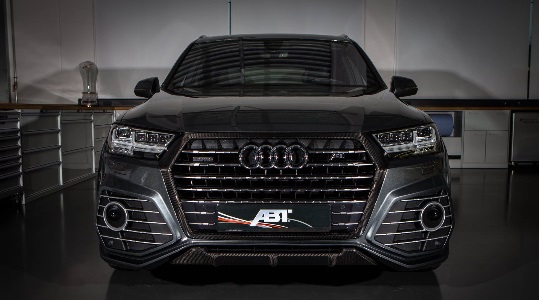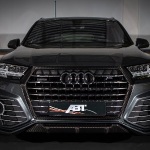There’s no question that this is an odd machine. It might seem like a good idea to turn your Q7 into a sports activity velociraptor, but after a few years, when it’s time to sell it, you’ll realize nobody wants it.
But we digress; the point is that the QS7 has evolved since the last time we saw it. It’s changed color from white to gunmetal grey, which is a more discreet way of drawing attention to all the carbon fiber. Several exterior trim pieces have been made from the material, including the grille and the skid pads. Because you need expensive carbon in the first place rocks will hit your car, right?
Those long trim pieces at the bottom of the doors that are usually chromed are also carbon. To justify getting the letter S, ABT widened the Audi SUV by quite a bit. A quad exhaust system has also been installed and is much cooler than the one on the production SQ7 model.
Yet it’s the interior that caught my attention because it’s one of the first all-carbon cabins I’ve seen. And I’m not talking about the super-lightweight style used by Lamborghini limited-production cars. No, this is about opulence. The best example of this is that the seat bottoms and backs feature this material, even though it’s not needed there. The steering wheel, dash and doors all feature this black waved material as well. Another feature I liked was the white leather gear stick. Audi designed that piece so you can rest your hand on it, so ABT used it as a focal point.
The tuners have toyed with the engines as well. They say the 3-liter TFSI can produce an extra 77 PS for a grand total of 410. In the diesel department, the single-turbo 3.0 TDI goes up from 272 to 325 PS using chip tuning technology.













